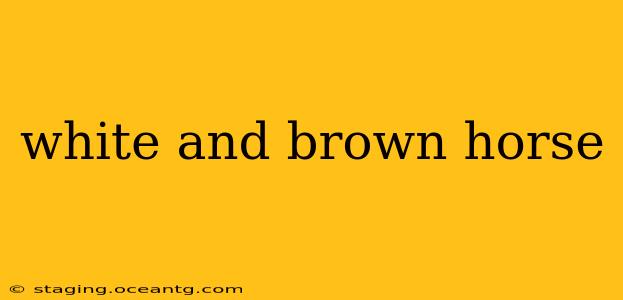Horses come in a stunning array of colors, and the combination of white and brown creates particularly striking appearances. This guide delves into the various ways white and brown appear in equine coats, exploring the genetics behind these colors and highlighting some breeds known for these coat patterns. We'll also address some common questions surrounding these beautiful animals.
What are the different brown and white horse coat patterns?
The terms "brown" and "white" in horse coat descriptions aren't always straightforward. "Brown" encompasses a range of shades, from dark bay (almost black) to light chestnut (a reddish-brown). "White" can refer to true white (lack of pigment) or to markings that appear white but might have underlying pigment.
Several patterns incorporate both brown and white:
-
Bay: A bay horse has a brown body and a black mane and tail. This is a common base color, and many variations exist, ranging from dark bay to light bay. White markings, such as a blaze (a wide white stripe down the face), socks (white markings on the legs), or a star (a small white marking on the forehead), are frequently seen on bay horses, creating a beautiful blend of brown and white.
-
Chestnut: Chestnut horses range from a light, golden color to a dark, reddish-brown. Again, white markings commonly accompany this base coat color, producing an equally stunning contrast.
-
Skewbald: Skewbald horses have patches of white and other colors, often including brown. The white patches are irregular and scattered across the body. It’s crucial to remember that "skewbald" describes the pattern, not a specific color combination.
-
Piebald: Similar to skewbald, piebald horses have patches of white and another color (often black, but brown can be included). However, piebalds tend to have larger, more clearly defined white patches than skewbalds. Again, this refers to the pattern and not a specific color.
What breeds of horses are known for having white and brown coats?
Many breeds can exhibit white and brown coats, but some are more commonly associated with these color combinations:
-
Gypsy Vanner Horses: These horses often have a striking combination of brown and white, frequently displaying flashy feathering (long hair on the lower legs) that enhances the contrast.
-
American Paint Horses: The name itself suggests a variety of color patterns, and many American Paint Horses feature brown and white markings in stunning combinations. Their coats can showcase a broad spectrum of brown shades coupled with irregular white patches.
-
Norwegian Fjord Horses: While primarily known for their dun color (a yellowish-brown with a dark dorsal stripe), some Fjord horses can exhibit lighter dun shades that, combined with their flaxen manes and tails and occasionally white markings, result in a coat that incorporates brown and white.
What causes a horse to have a white and brown coat?
The color of a horse's coat is determined by its genes. The specific genes involved are complex, but the basic principles are:
-
Base coat color genes: These genes determine the underlying color of the horse's coat, such as bay, chestnut, or black.
-
Dilution genes: These genes can lighten the base coat color. For example, a cream dilution gene can lighten a chestnut horse to a palomino (golden) color, which, combined with white markings, can lead to beautiful white and brown combinations.
-
White spotting genes: These genes influence the distribution of white markings on the horse's body, resulting in patterns like skewbald or piebald.
Are white and brown horses rare?
The rarity of a white and brown horse depends on the specific pattern and the breed. Horses with just a few white markings on a brown base coat are fairly common. However, horses with extensive white markings (like skewbalds or piebalds) incorporating brown are less common, depending on the breed.
What are some common health concerns for white and brown horses?
While coat color doesn't directly cause health issues, horses with extensive white markings might be slightly more susceptible to sunburn in areas with little pigment. Providing adequate sun protection (like fly sheets) can help mitigate this. It's important to remember that general equine health concerns apply regardless of coat color.
This guide offers a general overview. The intricacies of equine coat genetics are vast, and individual variations are numerous. For more detailed information, consulting with equine genetics experts or breed registries is recommended.
